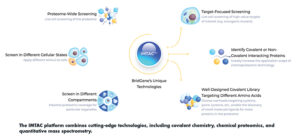Issue:January/February 2024
DRUG DISCOVERY - Overcoming Traditional Challenges: Innovative Chemoproteomics Strategies to Revolutionize Drug Discovery
ADVANCING DRUG DISCOVERY: NEW STRATEGIES FOR ENHANCED EFFICACY AND SUCCESS
In the realm of drug discovery, two primary approaches take center stage: Phenotypic Drug Discovery (PDD) and Target-Based Drug Discovery (TDD). Each approach offers unique advantages and has contributed significantly to the development of novel therapeutic agents.
PDD involves the identification of compounds that can modify the disease phenotype without prior knowledge of the specific molecular target. Instead of focusing on a predetermined target, PDD screens potential drug candidates based on their ability to elicit a desired therapeutic effect in cellular or animal models. This approach allows for the discovery of drugs that may act through previously unknown mechanisms, opening up opportunities for uncovering new pathways and molecular interactions.
TDD aims to find drugs that can interact with a specific target molecule that is believed to play a crucial role in the disease process. TDD relies on a profound understanding of the underlying biological pathways and molecular targets associated with the disease. By precisely targeting a known molecular player, TDD offers the advantage of increased specificity and reduced off-target effects, potentially enhancing the drug’s safety and efficacy profile.
Both PDD and TDD offer distinct advantages, and in recent years, researchers have increasingly recognized the value of integrating these approaches in a complementary manner. This innovative hybrid strategy combines the strengths of both PDD and TDD, leading to more effective drug development processes. It allows for the identification of novel compounds through phenotypic screening while simultaneously gaining insights into their underlying targets through subsequent investigations.
In this context, BridGene’s Chemoproteomic platform IMTAC™ (Isobaric Mass-Tagged Affinity Characterization) has emerged as one of the most powerful technologies to seamlessly merge the benefits of PDD and TDD. By utilizing IMTAC, researchers can efficiently analyze the interactions between potential drug compounds and cellular proteins, allowing for the identification and validation of target molecules associated with specific phenotypic responses. This technology empowers scientists to explore new avenues in drug discovery by bridging the gap between phenotypic screening and target identification.
The IMTAC platform consists of three key components:
- Designing and synthesizing a high-quality library of covalent small molecules.
- Screening against the entire proteome of live cells: The heart of the IMTAC platform lies in its unique capability to screen the designed small molecules against the entire proteome of live cells. The small molecules will selectively bind to structurally matching protein pockets and form covalent bonds.
- Qualitative and quantitative mass spectrometry analysis: This analytical prowess enables the identification and characterization of the interacting proteins. Moreover, it quantifies the binding strengths of these interactions, offering valuable insights into affinity and selectivity, critical factors in successful drug discovery.
Through the integration of these three key components, the IMTAC platform revolutionizes drug discovery by providing researchers with a comprehensive understanding of the proteome’s interactions and responses to covalent small molecules. This information opens new doors for the development of highly targeted and effective therapeutics, offering a promising path toward addressing unmet medical needs and improving patient outcomes.
In a remarkable step toward advancing drug discovery, BridGene and Takeda Pharmaceuticals have joined forces in a substantial collaboration aimed at implementing a cutting-edge drug development approach that combines PDD and TDD. This strategic partnership is particularly focused on tackling the complexities of neurodegenerative diseases, signaling a shared commitment to revolutionizing therapeutic interventions in this critical area of medicine.
This forward-thinking partnership between BridGene and Takeda Pharmaceuticals not only represents a significant advancement in drug discovery, but also showcases the commitment of both organizations to addressing the challenges posed by neurodegenerative diseases. By harnessing the potential of PDD+TDD strategies, the collaboration endeavors to pave the way for novel and more effective therapeutic solutions, bringing hope to patients and their families.
UNLOCKING NEW FRONTIERS IN DRUG DISCOVERY: TARGETING “UNDRUGGABLE” PROTEINS WITH IMTAC™
The human proteome comprises more than 20,000 proteins, with approximately 12,000 proteins having been identified as playing a role in human diseases and are therefore considered potential targets for precision treatment. Despite this large number, approximately 10% of the protein targets have been targeted by drugs approved by the FDA in the past few decades. In essence, a substantial majority of potential drug targets within the human proteome still lack corresponding therapeutic interventions. Many of these targets are often deemed “undruggable” due to their structural or functional characteristics, presenting significant challenges in designing small molecule drugs that can selectively bind and modulate their activities. Several common reasons contribute to the classification of certain targets as “undruggable,” including:
Lack of Binding Sites: Some targets lack well-defined binding pockets that can accommodate small molecule ligands, thereby restricting the feasibility of traditional drug binding approaches.
Protein-Protein Interactions or Transient Nature: The pockets of certain targets may exhibit transient or dynamic properties, complicating efforts to capture and stabilize them using small molecule drugs.
Traditional drug discovery techniques typically rely on screening small molecule libraries against a purified protein in a non-cellular environment. However, these methods may prove ineffective in targeting proteins with shallow or transient pockets. Moreover, purified proteins may not fully represent the dynamic protein interactions and structural complexity of the target within living cells. Consequently, traditional approaches often fall short when it comes to discovering drugs capable of effectively engaging “undruggable” targets.
BridGene’s revolutionary Chemoproteomic platform, IMTAC, stands at the forefront of drug discovery, offering a transformative solution to the long-standing challenge of targeting “undruggable” proteins. Through IMTAC, researchers can unlock unprecedented opportunities for developing therapeutic agents against a wide array of elusive targets. The platform boasts significant advantages that pave the way for groundbreaking advancements in drug development:
Efficient Discovery of Small Molecule Ligands for “Undruggable” Targets: IMTAC employs a dual strategy to tackle two main types of “undruggable” targets. For targets with shallow protein pockets, the platform utilizes covalent small molecules, expertly designed to form robust bonds with these challenging sites. For targets with temporary or transient pockets formed within live-cell environments, IMTAC leverages live-cell screening to identify ligands capable of engaging and modulating these dynamic targets. By skillfully combining these unique approaches, IMTAC opens a gateway to discovering small molecule ligands with remarkable potential for modulating the activity of “undruggable’ targets.”
Exploration of Targets With Unknown Structures in Living Cells: IMTAC empowers researchers to venture into uncharted territory, enabling the pursuit of targets with unknown structures. By probing the entire proteome within living cells, the platform provides an exceptional opportunity to unravel the intricacies of protein interactions and cellular responses. Simultaneously, IMTAC offers critical insights into the properties of molecules, such as their cellular permeability, activity, and selectivity. This multifaceted information equips researchers with a comprehensive understanding of the drug candidates’ behaviors in living systems, accelerating the path to identifying potential therapeutic leads.
Through BridGene’s IMTAC platform, the pursuit of “undruggable” targets transcends previous limitations, ushering in a new era of therapeutic interventions. By harnessing the platform’s unparalleled capabilities, researchers gain the means to confront diseases associated with challenging targets, instilling hope for patients and their families. With each successful discovery, the boundaries of drug development are pushed further, heralding a transformative future in medicine.
REVOLUTIONARY POTENTIAL OF COVALENT DRUGS: ADDRESSING THE LIMITATIONS OF NON-COVALENT THERAPIES
Covalent drugs have emerged as a highly promising therapeutic strategy, addressing the limitations faced by traditional non-covalent drugs, particularly when targeting challenging “undruggable’ proteins.”
To better understand their distinct mechanisms, envision non-covalent drugs as ships, gracefully docking into a harbor (protein pocket) that perfectly accommodates their shape. This docking disrupts the harbor’s traffic, modulating its signaling and controlling the associated disease. However, like ships that can sail in and out of the harbor freely, non-covalent drugs interact transiently with target proteins, limiting their sustained effects. In contrast, covalent drugs present a game-changing paradigm. When their ship docks into the protein pocket harbor, their covalent warhead forms an enduring covalent bond with a specific amino acid adjacent to the pocket. This bond acts like a steadfast anchor, preventing the ship from leaving the harbor and ensuring prolonged target engagement.
This unique mechanism confers several transformative advantages:
Higher Biochemical Efficiency: Covalent drugs’ irreversibility translates into higher biochemical efficiency, leading to potent and sustained effects on target proteins.
Stronger & More Persistent Effects: The stable covalent bond enables prolonged target modulation, resulting in stronger and more persistent therapeutic outcomes.
Reduced Dosage & Frequency of Administration: Covalent drugs often require lower doses and less-frequent administration due to their enduring impact, potentially minimizing side effects.
Separation of Pharmacokinetics and Pharmacodynamics: Covalent bonding allows for a clearer separation between drug clearance from the body and its pharmacological action, optimizing therapeutic potential.
Potential to Prevent Drug Resistance: By irreversibly modifying target proteins, covalent drugs can thwart the development of drug resistance, a formidable challenge in traditional non-covalent therapies.
Additionally, many target protein pockets are relatively shallow and lack the necessary features to effectively accommodate non-covalent drugs. These targets are often referred to as “undruggable” for non-covalent drugs. However, covalent drugs offer a groundbreaking solution by forming enduring covalent bonds with these elusive pockets, acting as steadfast anchors to regulate target signaling. A notable example is KRAS G12C, a historically “undruggable” target due to its shallow pocket. However, in 2013, Professor Shokat’s publication in Nature demonstrated the successful targeting of KRAS G12C with a covalent drug, subsequently leading to the industry’s development of covalent drugs against KRAS G12C.
Covalent drugs also possess unique advantages for targeting other types of “undruggable” targets, including:
Protein-Protein Interactions: covalent drugs can disrupt protein-protein interactions by covalently modifying one of the interacting proteins, thereby interrupting the interaction and modulating cellular signaling.
Disease-Driving Mutant Proteins: covalent drugs can exploit unique binding pockets or altered conformations present in disease-driving mutant proteins, allowing for the development of covalent inhibitors with specific activity against these mutants.
Redox-Regulatory Proteins: covalent drugs can specifically target and modify the cysteine residues within redox-regulatory proteins, thereby influencing the redox state of the protein and modulating its activity.
Enzyme Activation or Alteration: covalent compounds are well-suited for activating or altering the activity of enzymes in emerging therapeutic modalities that involve intervention in gain-of-function scenarios.
BridGene stands at the forefront of covalent drug discovery and development, leveraging proprietary covalent libraries for IMTAC screening and covalent PROTACs. Our expertise empowers us to unlock new therapeutic possibilities and revolutionize drug development with covalent drugs and covalent PROTACs, pushing the boundaries of medical advancements.
IMTAC™: A PIONEERING APPROACH TO BROAD PROTEOME EXPLORATION
IMTAC offers a distinct advantage by enabling the simultaneous exploration of the entire proteome, setting it apart from other drug discovery technologies that typically focus on individual targets. This unique capability allows IMTAC to rapidly discover a large number of small molecule ligands for diverse targets.
To date, IMTAC has successfully identified small molecule ligands for over 4,000 proteins, with approximately 75% of these targets lacking known ligands prior to the discovery.
This extensive coverage includes traditionally “undruggable” proteins, such as transcription factors, epigenetic regulators, splicing factors, and E3 ligases. These 4,000 proteins represent a valuable resource for the development of small molecule inhibitors, allosteric modulators, and the application of protein-degradation technologies to create degraders that impact protein activities.
Moreover, the broad spectrum of disease areas impacted by these 4,000 proteins spans oncology, immunology, CNS disorders, and more. This vast potential offers an exciting opportunity for collaborative efforts with other pharmaceutical companies to co-develop potential therapeutics. Leveraging IMTAC’s small molecule ligands, our partners benefit from streamlined lead optimization, allowing focused efforts on enhancing clinical efficacy, safety, and other critical parameters. This collaborative approach significantly expedites the drug development process, ultimately accelerating the delivery of new and effective treatments to patients in a shorter timeframe.

Dr. Ping Cao is the Co-founder and CEO of BridGene Biosciences, Inc. and has more than 18 years of biopharma industry experience in both large and small-molecule drug discovery research. An expert in biophysical/biochemical characterization of proteins/peptides focusing on leveraging mass spectrometry to support the biopharmaceutical pipeline, he has led teams that have helped advance multiple programs into the clinic in a variety of disease indications, including diabetes, obesity, dyslipidemia, and cardiovascular disease. He was responsible for establishing a state-of-the-art mass spectrometry and analytical group at Tularik, Inc. (acquired by Amgen in 2004). Most recently, he was the Head of the Protein Characterization Group in the Discovery Analytical Attributes Group at Amgen, Inc. He earned his PhD from the University of Texas at Austin in Analytical Chemistry and did his Post-doctoral fellowship at Genentech, Inc. He earned his MS in Chemical Engineering from SINOPEC Research Institute of Petroleum Processing in China and his BS in Physical Chemistry from Shandong University in Jinan, China.

Irene Yuan is the Co-Founder and Executive Vice President of BridGene Biosciences. She has more than 15 years of operation management experience. Prior to her role at BridGene, she served as Vice President at MUFG Union Bank and Chief Operation Officer at Redstar Global. She earned her BS in Economics and her BA in Business Administration and Law from Nankai University, and her Master of Sciences in Applied Economics and Finance from the University of California, Santa Cruz.
Total Page Views: 3163












